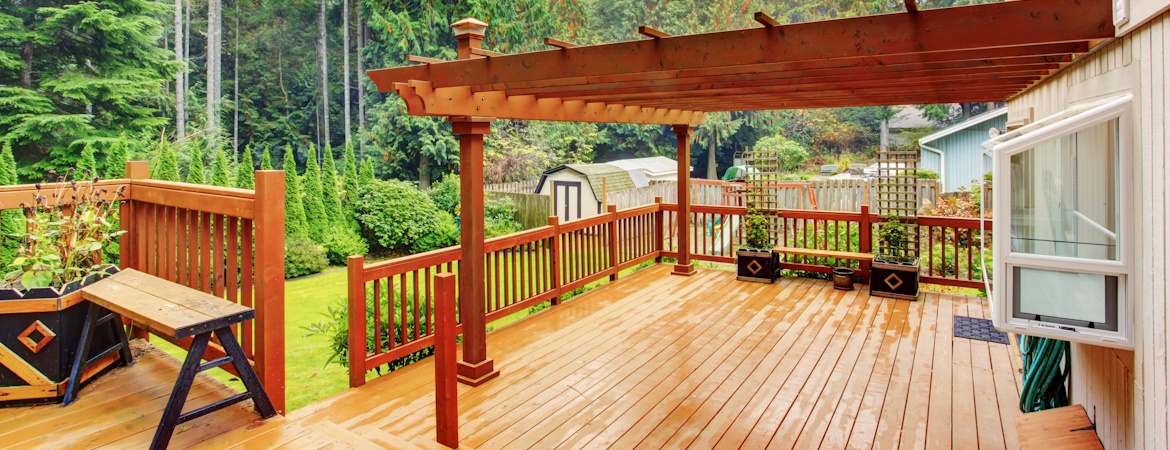Unsure If You Need a Professional Deck Builder? We Shed Light on What to Look Out For!
A new deck is a fantastic way to add outdoor living space to your home. It’s the perfect location for relaxing, hosting, meals, and spending family time together.
But exposed to the elements throughout the year, it’s natural to wonder how well your deck will hold up for each season and when it might be time for a replacement. Luckily there are some key signs to look out for that can help you make your decision. Let’s explore what to look for if you think you might need a new composite or wood deck.
1. Your Deck is Getting Old
Depending on use and exposure, a professionally installed wood deck should last 10 to 15 years and some DIY decks might not hold out as long, with replacements expected every five to seven years.
Exposure to the elements, gaps in maintenance, natural wear and tear, and decay from pests mean that older decks often become compromised in structure, function, and safety.
If you’re unsure how old your deck is or want to plan ahead for when deck replacement is necessary, reach out to your local deck builder. A trustworthy deck installation company will evaluate your deck and help you understand its condition and when it might need to be replaced.
2. Your Wood Deck Isn’t As Beautiful As It Once Was
Both wood and composite decking are designed to brave the elements and regular use. However, there are certain obvious signs that indicate your deck is not in the condition it once was.
For wood decks, physical signs of deterioration include warping, decaying boards, protruding nails, and insect damage. For composite decking, fading, mold growth, and scratches or gouges are signs of deterioration to watch out for.
These signs can help you identify if you’re in need for a deck repair or replacement. The great news is that if your deck is older than 15 years, newer building techniques and materials mean your next deck will likely be designed and installed to a higher standard, improving the durability and quality.
3. The Deck Posts Are Compromised
Common problems that many decks have is moisture accumulation at the base of the deck posts or sinking footers. Just like any part of a wooden deck, check for signs of cracking, rotting, mold growth, and soft and spongy texture. Another sign that your deck posts are compromised is if they feel loose, weak or wobbly.
As deck posts are vital for the structural support of your whole deck, address damaged, rotting, or sinking deck posts in a timely manner. If one or two individual posts are damaged, it might be possible to replace them individually, however if several deck posts are damaged, and there are other signs of wear and damage present too, a full composite or wood deck replacement is smart to ensure your family’s safety.
4. Broken or Wobbly Rails
Have you checked your railings? Broken, loose, or wobbly rails can be very unsafe and unsightly. Rot, water damage, pest damage, and improper fasteners used for DIY decking are all causes of wobbly and insecure railings.
If your railing is the only part of the deck that is broken or compromised, it’s possible that you can replace your railings without requiring a deck builder for an entire deck replacement. Inspect your railings and check for signs of weakness. But if the entire desk seems weak or old, it might be worthwhile to undergo a full deck replacement.
If you’re worried about broken or wobbly railings, a professional deck builder will offer you a free estimate and provide honest feedback on whether you’ll need a whole deck installation or just a railing replacement.
5. The Ledger Board Is Deteriorating
The ledger board is the part of the deck that secures the deck to your home, providing support for the joists. If any part of the ledger board is weak, pulling away from your house, or showing signs of deterioration, it can mean your entire deck is at risk of further damage.
As ledger boards are mostly hidden, they can be especially susceptible to unseen pests, wood rot, and any other type of moisture-related damage. If you suspect your ledger board is deteriorating, it might be time for a new wood deck installation.
6. Weak or Damaged Deck Joists
Deck joists are the wood beams that support the wood floor planks on your deck. The joists attach to the ledger board, creating the platform for the deck’s surface.
Weak joists can come from moisture and decaying debris that accumulates between deck boards. Joists can show signs of decay and rot such as a soft spongy feel, cracking and splintering wood, and the smell of mold or mildew. If you notice any of these signs, you may need to replace your deck.
If you’re not sure of the state of your deck joists, reach out to a professional deck builder. They will be happy to help you identify the signs of damaged deck joists and help you navigate the process if you need a replacement.
Bonus Tip: When In Doubt, Try the Rotted Wood Test
If you want to test for rotting wooden boards, posts, joists, ledger board, or rails, try the rotted wood test. Use a pointed tool such as a screwdriver, hobby knife, or awl to push into the wood. If you’re able to pierce the wood without applying too much pressure, it’s a strong indicator that the wood is weak and rotted. Rotted wood anywhere on the deck should be replaced.
For Advice, Inspections, and Professional Deck Installations, Call On the Professionals!
Opting for a deck from professional deck builders streamlines the process of planning, inspections, measurements, and construction while also ensuring the structural integrity and quality of your deck. Whether you’re looking for a wood or composite decking, choosing a professional deck builder means letting an expert handle all the details so you don’t have to.
To discuss your new deck installation or request an inspection, call your local deck building company to talk you through your options and help create the perfect deck for you.

